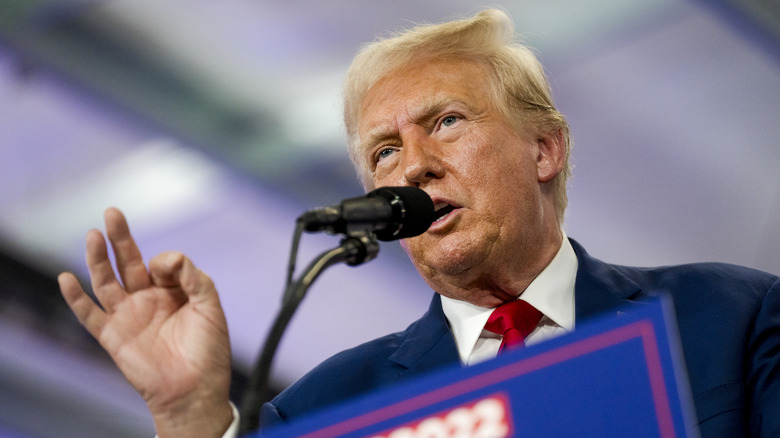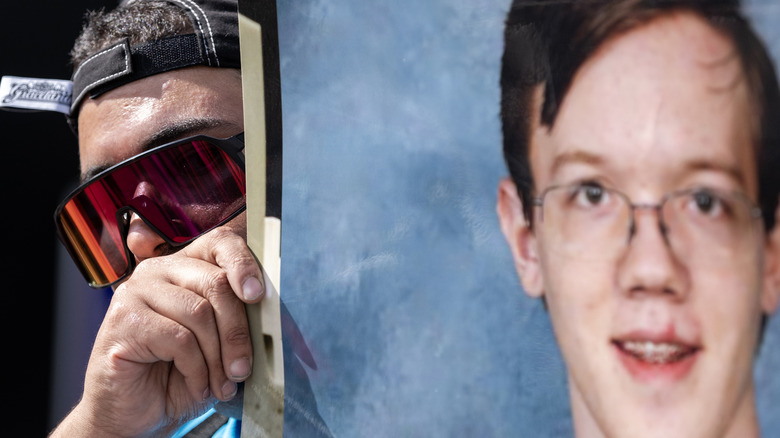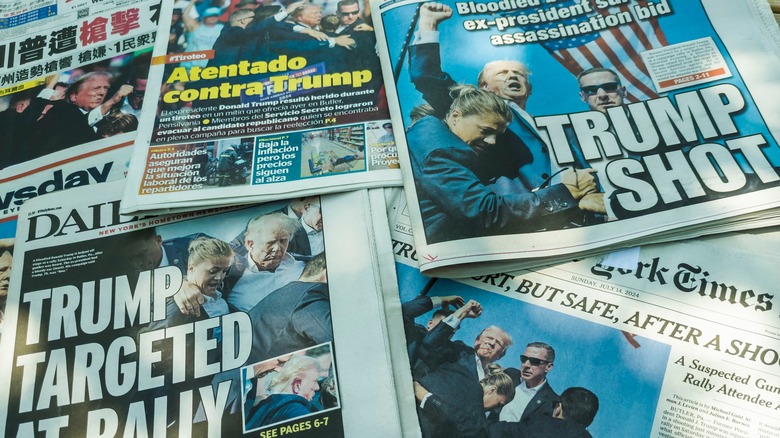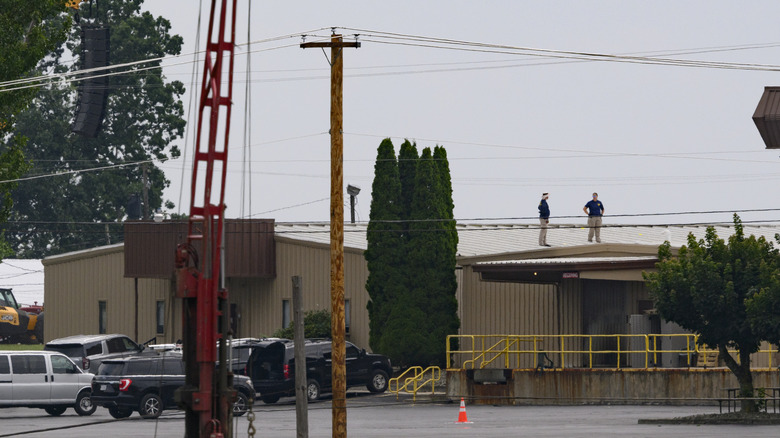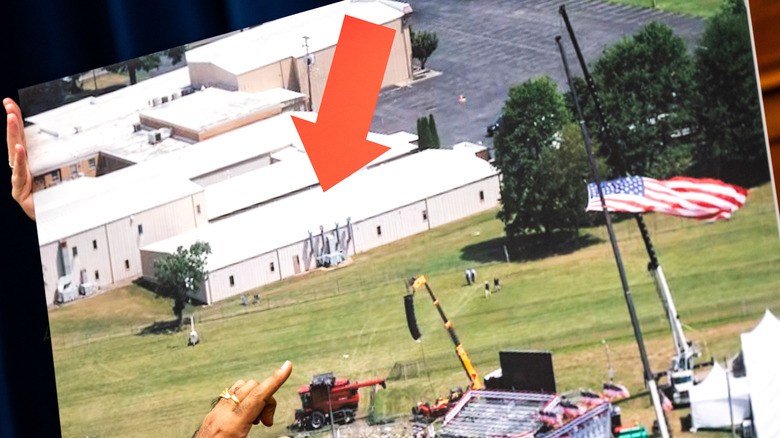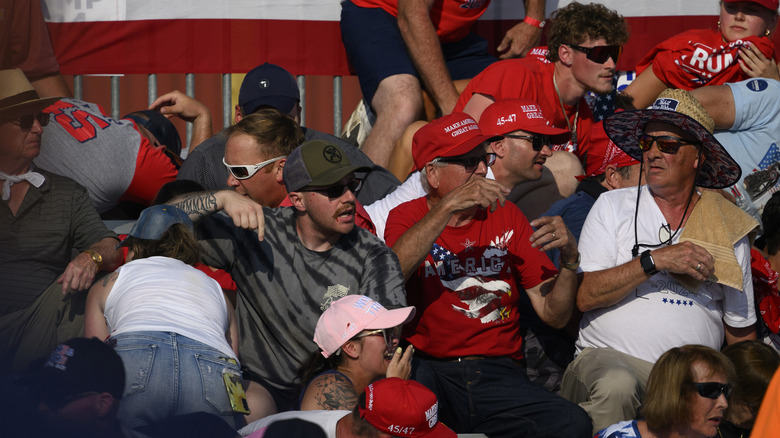Things That Still Don't Make Sense About Donald Trump's Would-Be Assassin
Even only a week after the assassination attempt on Donald Trump's life in Butler, Pennsylvania, The New Yorker posted the headline, "Are we already moving on from the assassination attempt on Donald Trump?" And indeed, with all the typical pre-presidential election nonsense that was cycling through news outlets — on top of all the usual nonsense — it definitely seemed like everyone sort of shoulder-shrugged the whole live-on-TV-once-in-a-generation-bullet-to-the-ear thing. But questions still remain — lots of questions. This is especially true of the shooter, Thomas Matthew Crooks. Answering these questions is critical not only to understanding the whys and hows of what happened, but making sure something similar doesn't happen again.
Before we go into any of the strangeness surrounding Crooks' assassination attempt on Trump, it's important to remember that we're not crying "conspiracy." Rather, questions illustrate a desire to make sense of events. Besides, the babble of conspiracies already flooded the internet within minutes of Crooks taking his shots, particularly of the "It was staged" variety.
On the real side of things that don't make sense we've got Crook's motivation, which still doesn't seem potent enough to drive an assassination attempt. Then there's the continuing matter of how he got into the Trump rally with a rifle and onto a roof, and why he was spotted and tracked by authorities along the way but not stopped. Then there's the detonator he had on him. Finally, there's the fate of his body, which has already been cremated.
Thomas Matthew Crook's motivations remain unclear
Things would be much simpler if Thomas Matthew Crooks' decisions had a clear throughline: First he thought this, then he thought that, he wrote his thoughts here, he outlined his plan there, event A pushed him to the breaking point, he was affiliated with group B, fell under the influence of C, etc. But no. Crooks remains an enigma and his motivations unclear. But bear in mind that the desire for such clear answers speaks more of us than the culprit.
No general information about Crooks seems to justify his actions. For instance, his family was marked by the Trump campaign back in 2016 as potential supporters who would be receptive to pro-gun messaging. His father is registered as a Libertarian and his mother as a Democrat. Both are licensed social workers. Crooks himself made a donation to the Biden-supporting Progressive Turnout Project in 2021 before he was old enough to vote. He was also rejected from his high school rifle team. Crooks was described by those that knew him using generic terms like "nice" and "normal."
While there are some hints in there about Crooks' future actions, sociologist Ana Velitchkova summarized him to The Washington Post as having "no extremist ideology, no mental health issues, no struggles at school, no family issues." He also wasn't involved with scapegoat go-tos like incels, "satanic neo-Nazi" groups, or militant Islamists. Retired FBI agent Karl Schmae, meanwhile, compared Crooks to would-be Ronald Reagan assassin John Hinckley Jr., who just wanted to be noticed.
His body was already cremated
With such a high-profile case as an assassination attempt of a U.S. presidential candidate, it makes sense that all avenues would be covered when getting to the bottom of what happened. Along those lines, U.S. Representative Clay Higgins — a member of the Task Force on the Attempted Assassination of Donald J. Trump — wanted to have a look at Thomas Matthew Crooks' body at some point following the shooting. But as the Daily Mail reports, Higgins learned that the FBI released Crooks' body back to the shooter's family 10 days after the assassination attempt. His remains have since been cremated.
It's not exactly unreasonable that a 20-year-old's family would want their son's remains, nor is it especially odd to opt for cremation rather than burial, nor can we assume that there's much to gain by continuing to examine Crooks' body. After all, he was shot and killed by a Secret Service sniper — that's pretty much it. But per the Daily Mail, Higgins called the release of Crooks' remains "disturbing" and implied that the FBI are intentionally trying to interfere with proceedings. He was also upset that the bureau didn't announce that it had released the body.
Others have used the opportunity to continue murmuring about conspiracies and cover-ups. The FBI, meanwhile, called Higgin's statements "inaccurate and unfounded." Nonetheless, given the importance of the case, it's not unreasonable to assume that the FBI would treat Crooks' body like a piece of evidence while investigations continued — at least for a while.
His remote detonator
While Thomas Matthew Crooks' plan was obvious in one regard — shoot Donald Trump — other parts aren't clear. It isn't even clear how clear of a plan he had. To that point, there's the homemade "detonator" that was found on Crooks' body. The device resembled a cheap, gray remote control and was photographed with what was presumably a backup 9-volt battery.
The remote control, as CNN explains, was connected to a receiver hooked up to explosives in Crooks' car, which was parked nearby. Reports indicate that the vehicle also contained a bulletproof vest and ammunition. The explosives themselves were homemade and the whole setup jury-rigged. But when authorities looked through Crooks' online browsing history, they found nothing related to crafting homemade explosives — just information related to his hobbies like gaming and coding. Then again, it's not like people don't know how to use private browsing and VPNs at this point, especially an apparently tech-aware 20-year-old.
Questions related to the detonator connect to questions of Crooks' motivations and plan. What exactly was the intention behind loading up his car with explosives? Investigators were reportedly floating the idea that Crooks intended to use the explosion as a distraction at some point during the shooting, perhaps to let him escape if he thought that was possible. Then again, he might have had something completely different in mind. Without more evidence, it's unlikely we'll ever know.
He got onto the roof with a rifle
Now we come to the question of how a lone man carrying a rifle climbed onto the roof of an unguarded building a mere 443 feet away from Donald Trump. There's a lot to consider here, including the physical mechanics of Thomas Matthew Crooks climbing onto a roof in broad daylight, his overall infiltration of Donald Trump's rally, and the catastrophic failure of security personnel involved. On the day of the attack, multiple people in the crowd saw Crooks and pointed him out to authorities. But as it turns out, Secret Service agents had already seen him on the roof at least 20 minutes before he took aim at Trump and didn't intervene. In fact, Crooks was deemed a "suspicious" person within an hour of when Trump took the stage, per the New York Post. Crooks had even ridden around the rally on his bicycle casing the place out and flown a drone around the area for an aerial view.
On top of this, the CBC reported Crooks somehow used some unspecified "mechanical equipment" to climb up on the roof via pipes. And then, Secret Service Director Kimberly Cheatle, who has since resigned, told ABC News that the area was unmanned because it had a slope and was therefore dangerous for agents to be positioned on. But, security later stood on the roof without any problems while staring down at Crooks' body. Even if there's an explanation for every one of these issues, all together they present a portrait that makes little sense.
Thomas Matthew Crooks apparently acted alone
There's one final question that wraps the previous questions in this article all together: Whether or not Thomas Matthew Crooks acted alone. As the BBC reports, the FBI says that he did, and that's that. Per AP News, classmate Jason Kohler reported that Crooks was indeed a loner who was "bullied almost every day" and sat by himself at lunch. Others like Gina Ligon — head of the National Counterterrorism Innovation, Technology and Education Center (NCITE) at the University of Nebraska Omaha — agree that he fits the "lone wolf" profile, per The Washington Post. Like the aforementioned John Hinckey Jr., Ligon said that Crooks acted like someone who wanted to be remembered.
On the other hand, Ligon added, "Nobody acts alone — except the Unabomber." Without wading into conspiratorial territory — and in the absence of further evidence — it does seem reasonable to speculate that Crooks at least chatted with someone about his plans leading up to his attack. Despite Crooks' AR-style rifle belonging to his father, despite the apparent lack of connections between him and extremist groups, despite his lack of clear ideological drives, despite his explosives being homemade, Ligon and other analysts told The Washington Post that he came equipped with markers of a wider "ecosystem." In other words, even if Crooks did organize and plan his attack without a shred of involvement from anyone else, he at least took influence from various sources.
